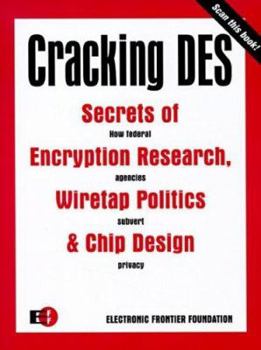Cracking Des: Secrets of Encryption Research, Wiretap Politics & Chip Design
Select Format
Select Condition 
Book Overview
Sometimes you have to do good engineering to straighten out twisted politics. The Electronic Frontier Foundation, a nonprofit organization that was founded to ensure that the principles embodied in... This description may be from another edition of this product.
Format:Paperback
Language:English
ISBN:1565925203
ISBN13:9781565925205
Release Date:July 1998
Publisher:O'Reilly Media
Length:266 Pages
Weight:0.90 lbs.
Dimensions:0.6" x 7.0" x 9.1"
Customer Reviews
2 ratings
Useful to both cryppies and hardware geeks
Published by Thriftbooks.com User , 20 years ago
In 1997, the Electronic Frontier Foundation announced an experiment. On a budget of $200,000, they blew the roof off of something that had long been suspected: the long-time United States Data Encryption Standard was not secure. This is something that had been suspected for some time. The original Lucifer encrypt that it had been based on had been designed by IBM with a 64-bit keyspace (quite large for the late 70s), but had been reduced to 56 bits, reducing the number of possible keys by two orders of magnitude. It was widely suspected that this was due to the NSA's desire that there not be a standard in the public domain that they couldn't crack; indeed, DES was slowly obsoleted over the years by ciphers like RSA and PGP. In 1997, it was announced that the EFF had created, using an array of custom chips, a relatively inexpensive system that was capable of a brute-force attack on DES, and came to the conclusion that such systems were probably already in the posession of not only the NSA (the largest purchaser of computing power in the world) but also numerous corporate and governmental entities that could afford to pay substantially less than the EFF paid for a technology that was likely not only available on the QT but quite mature.This book comes with everything needed to build a DES cracker -- operational notes, history, and even the VHDL code needed to build the custom chips and C code to control the chip array. This makes it of interest not only to cryptography researchers (who probably consider this book old news after seven years) but to those learning about hardware and embedded systems development; the extensive listings make for good study material. It's a worthwhile book to buy for anyone interested in privacy and cryptography concerns, though for the layperson Simon Singh's Code Book is probably a more general introduction to the issues involved.
Detailed blueprint on how-to-do it.
Published by Thriftbooks.com User , 25 years ago
This is a "killer book" in every respect.The authors have done a tremendous service to the entire population of the World by exposing the vulnerability of the DES algorithm. The DES algorithm is the formula for encrypting your bank account and keeping other secrets safe. DES has become unless and the authors have taken more than a little risk to inform you including absolute, undeniable proof in the form of "showing you how", down to the last detail.The books not only gives detailed plans and references but also the correct current political motivation behind the desire to retain the DES and how it affects you. Details of how government "politicking" of your civil rights and how those rights are being "watered down" for the benefit of the intelligence community is explained, too.I don't personally plan on spending $200,000 or so to build a "engine for cracking DES", but I do believe that the money spent for this book was one of the better investments I have made. The books contents have been placed into the public domain by the authors. Tell a friend.Bravo, guys!




